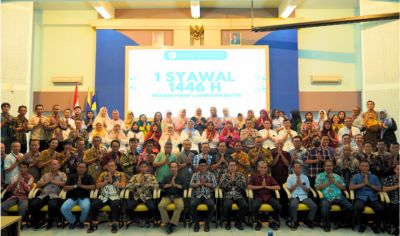PEOPLE are a country's most important resource. Having a young population (65% under 40 years – 2020 Population Census), with the 7th largest market size Quality human resources will enable Indonesia to become a developed country by 2045.
Human resource development has become President Joko Widodo's first and main priority. Earlier this month, President Jokowi emphasized that Indonesian human resources must be trendsetters (and not followers ). Trendsetting is certainly related to innovation, and innovation capability requires the right direction in human resource development. Higher education is the starting point.
How is higher education orchestrated so that Indonesian human resources become trendsetters ?
Indonesian higher education
Based on the 2020 Higher Education Statistics, there are 29,413 study programs held in Indonesia. Academic-based study programs still dominate (88.33% or 25,987 units). The largest number of study programs is still dominated by the field of education (6,032 units), followed by engineering, social, health and economics. The field of educational sciences has the largest number of new students (435,986 people), followed by economics, social, technical, health and other fields of science.
The largest number of college graduates came from education (21.84%), followed by economics (18.92%), engineering (16.02%), health (15.56%), social (13.95%), and the rest come from other fields. The question is, is the popularity of these study programs relevant and in line with Indonesia's current and future needs?
STEM Trends
Many governments focus education in their countries based on STEM ( science, technology, engineering, and mathematics ). Realizing the lack of interest of the younger generation in STEM fields, and that the nation's competitiveness was threatened, United States (US) President Barack Obama launched a program in 2011 to train 100,000 teachers who will teach STEM fields by 2021. Of course this is accompanied by funding commitments, not only from the government, but also from the private sector.
Through heated public debate, both for and against, the US Education Reform Act was finally signed by President Obama at the end of 2015, with an emphasis on STEM education. The goal is how to turn US youth into leaders in the STEM fields.
What about other countries? Global Innovation Index data shows that South Korea occupies the top position in Asia (#5 in the world), followed by Singapore (#8), China (#12), and Japan (#13).
This is inseparable from the large proportion of science and engineering produced. For example, Singapore is ranked 10th in the world, followed by India (#12) and South Korea (#18). It is not surprising that many CEOs of world technology companies come from India, or high-tech products from South Korea. How about Indonesia? We occupy 76th position in the world.
Lessons from China
Of course it is interesting to observe China's increase in position to 12th out of 132 countries (the highest in the upper middle-income countries ). Ten years ago, its position was still 29th. When Abrami et al (2014) wrote an article entitled ' Why China Can't Innovate' in the Harvard Business Review, most believed it. However, gradually the digital market, health equipment, and even sustainable technologies are starting to be controlled by Chinese companies.
One of the indicators for GII 2021 is human capital and research . In the last 25 years, China has seriously improved its innovation capabilities, especially human resources, by developing its universities (PT) to become world class. Starting with the 211 Project in 1995, the C9 League, and most recently the Double First-Class University Project with large funding. As a result, in 2021 China placed 6 of its universities in the Top 100 Times Higher Education World University Ranking . The highest universities in Malaysia are in the range 301-350, while Indonesia is in the range 801-1,000.
Data from the 2017 China Statistical Yearbook shows that 3 million students entered STEM programs, making it one of the countries with the largest percentage in this field. Not only relying on domestic graduates, but also graduates from world-class universities in developed countries. In this case the China Plus Approach is implemented (Greeven et al, 2019).
Since 1978, 4 million people have studied abroad and 2.2 million graduates have returned to China. Haigui (diaspora returnees) are becoming important players in China's innovation ecosystem, with training received from the world's best universities. In fact, before returning, they had worked in various world-class companies, especially Silicon Valley, and brought startup and best practices from the Fortune 500 to the domestic market. As a result, domestic companies are able to compete with world-class companies from developed countries.
The next indicator is the R&D budget allocated by each country. The biggest spender was the United States (US$491.86 billion), followed by China (US$471.70 billion) and Japan (US$154.16 billion). Meanwhile, Indonesia is only US$3.11 billion (0.10% of GDP). The results are clear, the patent applications of these countries are far superior to Indonesia's.
Japan has more than 7,005 patent applications compared to Indonesia. Malaysia has 90 times the R&D budget percentage 13 times larger. China is the world's largest patent proponent, beating the US. The lesson is that a world-class PT that produces competent human resources and world-class patents, supported by a large R&D budget, makes innovation a necessity.
Future technology
In order to guarantee its leadership in the technology sector, the Made in China 2025 will be continued with Created in China 2035 (a kind of Repelita in Indonesia). The government also assigned 12 top universities to develop the College of Future Technology .
The main task is to conduct research and develop revolutionary and disruptive technology in the next 10-15 years. Its existence is targeted to be able to compete with the Massachusetts Institute of Technology (MIT) and Stanford University in future technology.
Life and health technology is the focus of the College of Future Technology at Peking University. Its existence is centered on 2 interdisciplinary fields, namely biomedical engineering and molecular medicine. In collaboration with the University of Cambridge and MIT, South China University of Technology will open 2 new study programs, namely artificial intelligence and big data technology . Meanwhile, Beihang University was assigned to develop the School of Future Aerospace Technology . The establishment of the College of Future Technology is the first step to prepare Chinese human resources to excel in future technology.
Education is a long-term investment, and resource orchestration is needed to strengthen positioning as a trendsetter . Selecting, sorting and modifying existing study programs, commissioning the establishment of future-oriented study programs, and even closing them if they are less relevant is a must.
It's not necessarily what is popular now that graduates will need in the future. Providing a long-term vision for education is a must, especially to support the achievement of Advanced Indonesia 2045. Of course, without abandoning national values. What strategic industries will be Indonesia's advantages in the future can be used as a reference. And, of course, long-term funding commitments provide certainty and sustainability of the nation's competitiveness in the future.


























